We’ve all heard the term content is king.
Quite frankly it is.
In fact, according to the 2018 HubSpot State of Inbound Report, 61% of marketers say growing an SEO and organic presence is a high inbound marketing priority.
Here’s why…
Organic traffic is highly effective at driving long term, sustainable growth for your business, at a fraction of the cost of alternative strategies like paid media.
DOWNLOAD: The Complete Guide to Customer Acquisition. It's for teams looking to drive sustainable growth.
Enter Search Engine Optimisation (SEO).
An effective SEO strategy has the ability to draw in relevant traffic to your website and attract the right quality leads for your business.
In fact, according to research conducted by Backlinko and ClickFlow, the number 1 organic search result in a Google search has a CTR of 31.7%.
It’s important to note that a search engine like Google takes many factors into consideration when they rank pages. These factors include both the elements on each page, as well as how other sites reference and link to them.
In this blog post, we’re going to take a look at the on-page and off-page SEO tactics we know work as an effective acquisition strategy.
Let’s get started.
Here’s your TL:DR Summary
Your SEO strategy directly impacts your organic results and, therefore, your acquisition efforts. So here are 6 tried and tested SEO strategies that we are actively using to drive customer acquisition for our business.
On-page SEO tactics:
- Website and blog optimisations.
Did you know that organic results get 94% of the clicks compared to paid results? - Image optimisation.
This tactic has the ability to affect site speed, ranking and authority. - Effective internal linking strategy.
According to research by Databox, 42% of SEOs spend equal time building internal links as they do external links.
Off-page SEO tactics:
- Guest posting.
- Social media.
According to research, it’s the engagement rate of social media content that strongly correlates with higher organic rankings.
- Link building.
6 SEO tactics to boost your customer acquisition efforts.
To keep things practical, I’m going to show you how we have been able to successfully use SEO and our organic growth as an effective acquisition strategy.
Here we go:
On-page SEO.
1. Website and blog optimisation.
- Website Optimisation:
Your website needs to have a great user experience so that users can effectively move through their buyer’s journey and eventually convert on your site.
Did you know that organic search results get 94% of the clicks compared to paid search results?
With those kind of stats, it's easy to understand why optimising your website for relevant ranking search queries has the ability to boost acquisition for your business.
There are multiple ways that you can optimise your site for a boost in acquisition and, of course, ranking.
Take a look:
Your H1 and H2 tags: They need to be optimised for search and user intent. This will ensure that right-fit leads convert on your site.
Meta description: You need to optimise every page on your site by creating meta descriptions. They need to be engaging and optimised for your main search queries. According to a study conducted by Backlinko, pages that contained a meta description received 5.8% more clicks than pages without one.
Test your links: Broken links hinder a user’s experience and could result in a user bouncing off your site. You will want to spend time testing and fixing any broken links you may come across.
- Blog Optimisation:
The way in which you optimise your blog should be inline with a greater content marketing strategy.
DOWNLOAD: Content Marketing Strategy Template
It’s important to ensure that each blog you write, upload, and publish is optimised for a specific, targeted keyword.
As a part of your content strategy research, you will have identified a number of keywords you’d like your articles to be optimised for. The purpose of this process is to identify both short and long-tail keywords that a user may be searching for, this will result in more targeted traffic, that’s been optimised for conversion.
At Uku, we arrange our content using the topic cluster model, which means that we link each blog back to its core topic. This tactic ensures that your blog has the best-ranking ability it could possibly have.
Take a look at how we do this in HubSpot:
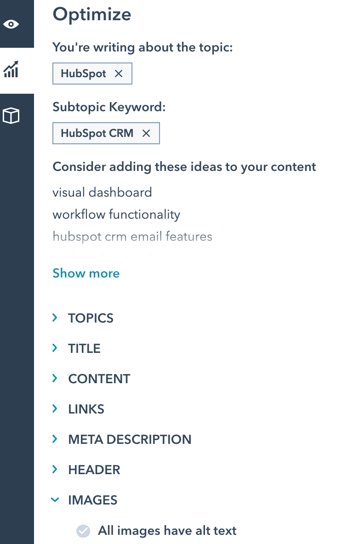
The process of blog optimisation includes the addition of internal and external links, meta descriptions, and adding alt. text to all of your images.
We will also add CTA’s throughout every blog to ensure that a user has a path to convert on at strategic points.
To take this even further we use what HubSpot calls “smart CTA’s”. These are specifically tailored to an individual user. For example; if a user has downloaded an Awareness eBook on our site, we will choose to dynamically change the CTA next time the user is on our site to offer them a different resource. In fact, research conducted by HubSpot found that these smart CTA’s convert 202% better.
2. Image optimisation across blog and website.
Optimising your images across your website and blog play a significant role in boosting your website’s ranking.
There are effectively two elements to this:
1. Image optimisation plays a role in your overall site speed. Site speed is a factor that Google looks at when ranking websites across the internet.
We use free tools like Google Page Speed Insights and GT Metrix to understand what our site speed is.
Both of these tools will give you a rating based on the URL you asked them to analyse as well as provide you with suggestions on what you can do to increase the speed at which your website loads.
What load time should you be aiming for?
According to Unbounce’s 2019 Page Speed Report, ideally, a web page should load in under 3 seconds, even on mobile.
The same study also indicated that approximately 70% of consumers admit that page speed impacts their willingness to buy from an online retailer. A direct impact on your acquisition efforts.
Yet only 3% of marketers say faster page loading times are their top priority.
2. Image optimisation plays a role in helping boost your website’s authority and ranking. This is done when you optimise your images for your primary keywords.
We use HubSpot to ensure that every image across our website and blog is optimised for the correct keyword. Just like this:
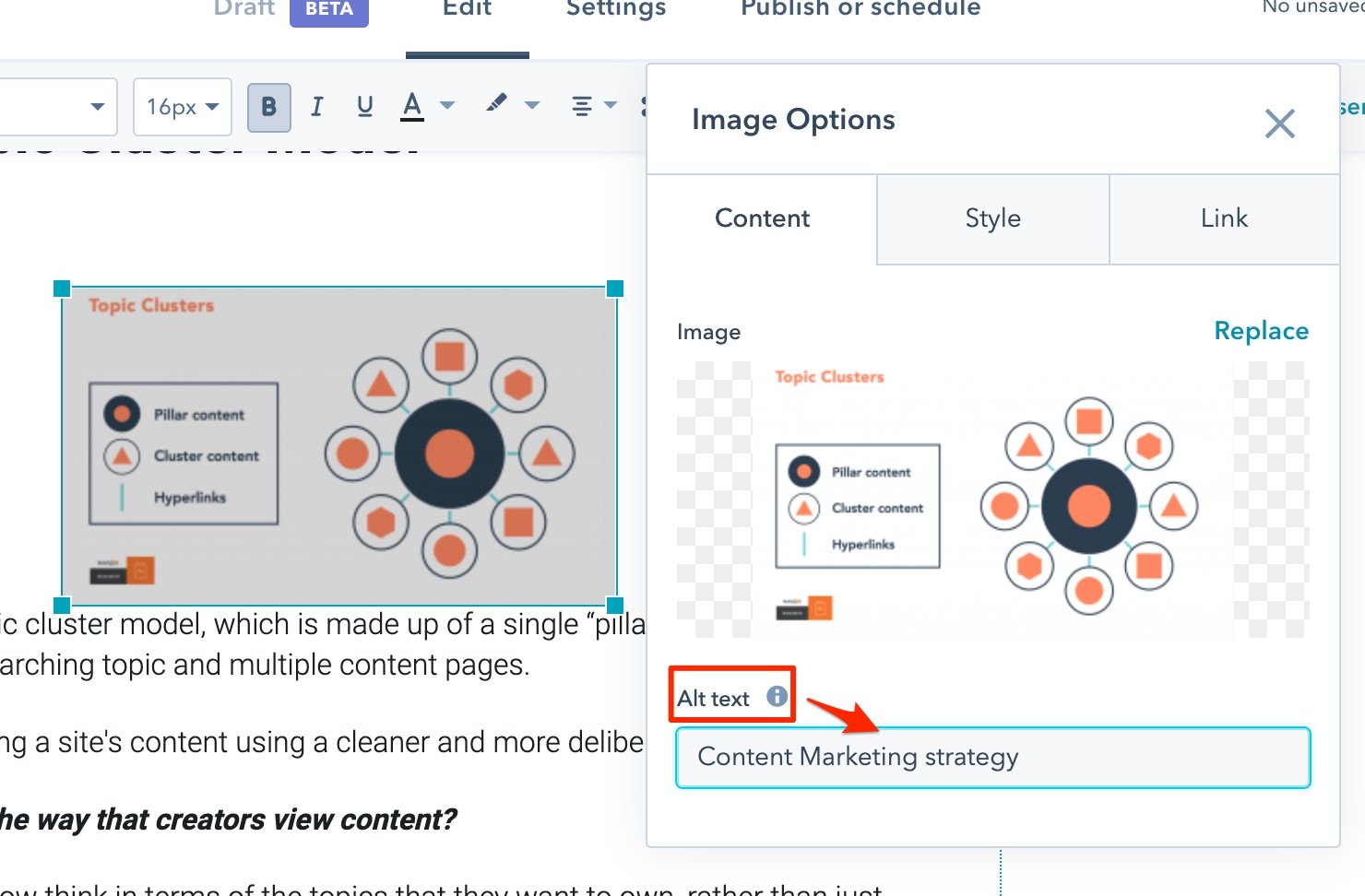
This provides Google with context to your pages, which in turn aids your long-term rankings.
3. Internal linking.
This specifically refers to the links that go from one page to another on the same domain.
We use internal linking for these reasons:
- Internal links provide a better user experience for those that land on your site.
- They also have the ability to share link equity throughout your site.
Take a look at how we structure our blog using internal linking, we specifically refer to this as topic clusters:
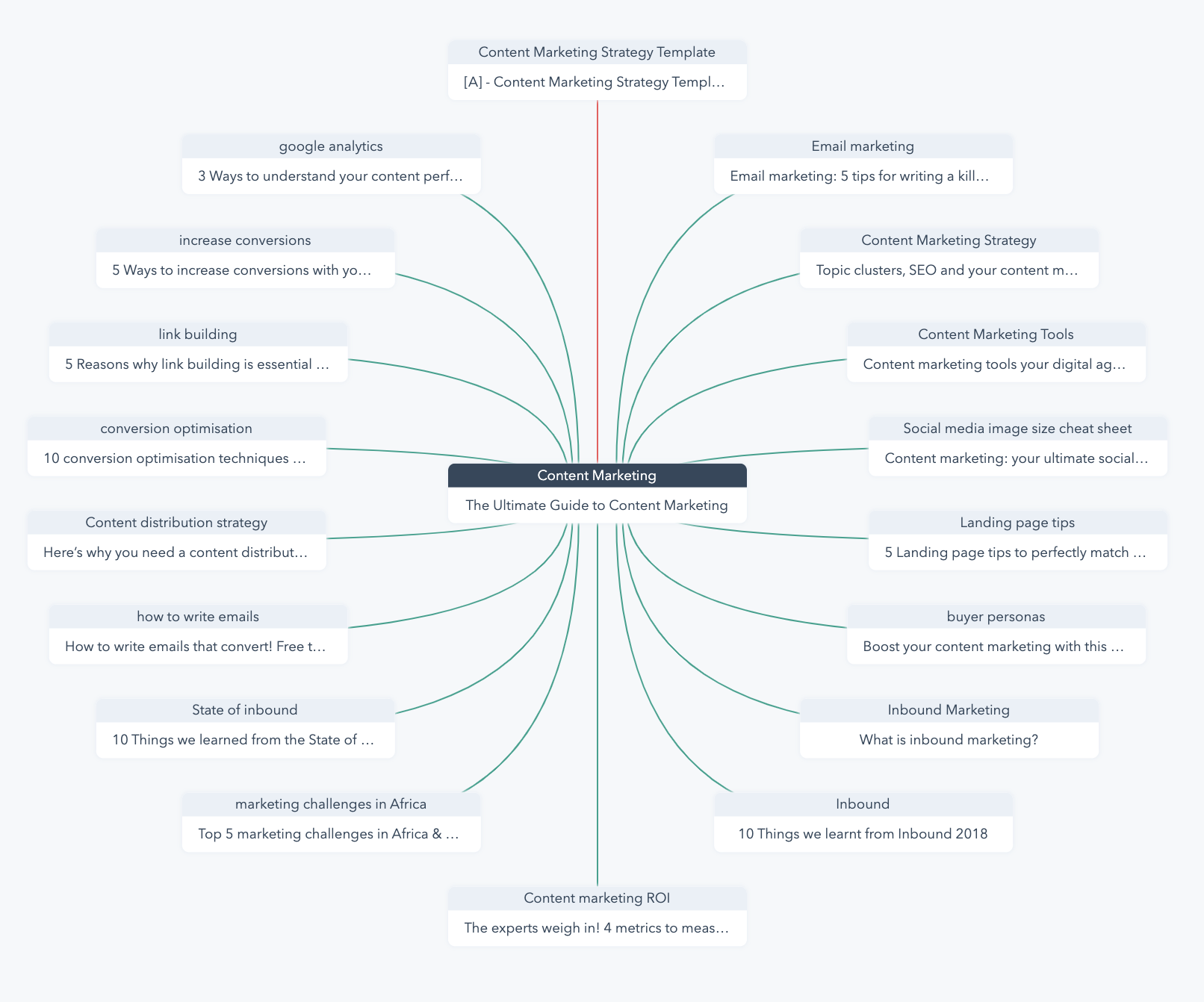
READ: Topic clusters, SEO and your content marketing strategy
We’ve created a core topic, that helps position us as an authority on a specific topic.
For example, if a user was looking for information related to content marketing, they would find our monster blog of 17, 000 words. This same search also provides link juice to all the linked blogs too.
According to Search Engine Land:
“A healthy internal linking strategy makes it easier for your pages to be indexed, boost ranking, as well as increasing click-through rates and conversion rates for visitors who can find what they are looking for.”
Off-page SEO tactics.
1. Guest post contributions.
Our team is dedicated to actively looking for opportunities to offer small written contributions to high-ranking, relevant sites.
Here’s why?
It’s customary for the external site to link straight back to your site. This results in a successful backlink.
This link from the higher ranking site passes authority to your site, which plays a role in how Google then crawls and ranks your site.
Below I’ve included what this has looked like for us over time. SEO is an always-on tactic that requires consistency to really experience the fruits of your hard work.

This tactic allows your business to build a position of authority and thought-leadership in your industry, it has the ability to boost website traffic and, of course, it increases the backlinks to your website.
Guest posting also allows your business to get in front of an audience you otherwise would not have had access to, building a level of brand awareness along the way.
2. Social media engagement.
According to research conducted by Larry King, he found that it's the engagement rate of social media content that strongly correlates with higher organic rankings.
Therefore, your social media should be used to increase and leverage the exposure that your content receives.
- Increased social media engagement has the ability to boost your organic rankings over time. Organic rankings increase your visibility in search, as a result increasing acquisition along with it.
- Increased social media engagement has the ability to boost website traffic. Increased website sessions also boost rankings and, therefore, acquisition.
This can be done both organically and through paid distribution tactics.
LinkedIn and Quora have been successful platforms for organic distribution for us, whereas Facebook has produced better engagement results through the addition of paid boosted posts.
Boosted posts allow you to pick an objective for your promotion, one of those being “post engagement”. This post should then be optimised according to your most relevant audience and the time frame in which you’d like the ad to run.
Here’s what a boosted Facebook post will look like:
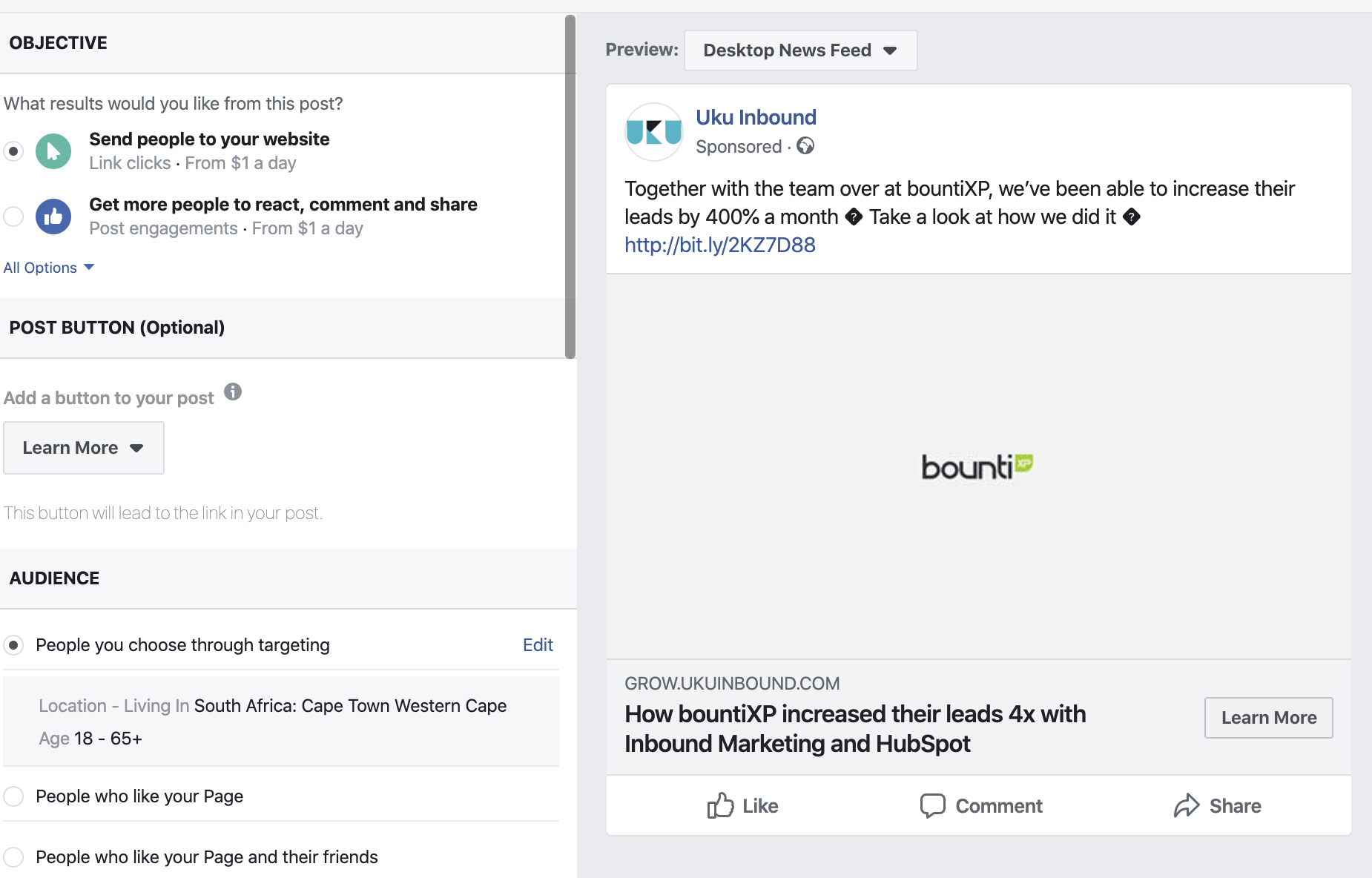
3. Link building.
Link building is multifaceted and can be a challenge to execute effectively and consistently.
There are a number of tactics that you can use to effectively build links back to your site.
1. You should list your business and website on Google My-Business.
Here’s what ours looks like as it’s listed on Google:
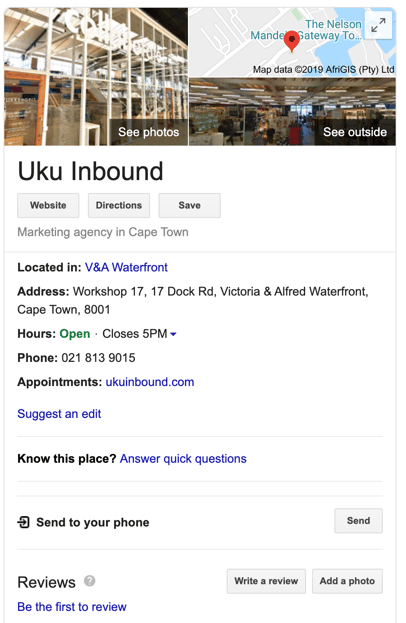
-
- You should get people to review your business listing on Google.
According to BrightLocal’s 2018 Local Consumer Review Survey, 86% of consumers read reviews for local businesses. Furthermore, a consumer will read an average of 10 online reviews before trusting a local business.
A Google business review creates transparency and provides a level of social proof to your product or service.
2. You can use email outreach to a list of relevant sites, requesting a link swap.
We develop relevant lists of businesses that we’d like to reach out to with the request of placing a link of ours on their website, and in return, we are more than happy to link out to a relevant external site on ours. So get in touch if that’s you 😊
I believe that the key to success with this tactic is to ensure you have a template that you’re able to customise in a highly personalised way. Businesses out there are busy and often don’t see the value in this kind of activity, but consistency will be your ticket to link building greatness.
According to research by Databox, 42% of SEOs spend equal time building internal links as they do external links.
READ: 5 Reasons why link building is essential to marketing success
Key Takeaways
SEO is a cost-effective and sustainable acquisition tactic.
The key with SEO will always be the consistency with which you’re able to execute these strategies.
There are multiple on-page and off-page tactics you can use to boost your businesses visibility which will ultimately result in an uptick in acquisition.
SEO is not an overnight tactic and requires an always-on approach to achieve those great results.
If you’re looking for more top tips and a tried and tested acquisition framework, then take a look at our most recent ebook. It tackles everything and it’s all in one place. Simply click the button below to get your copy 👇



